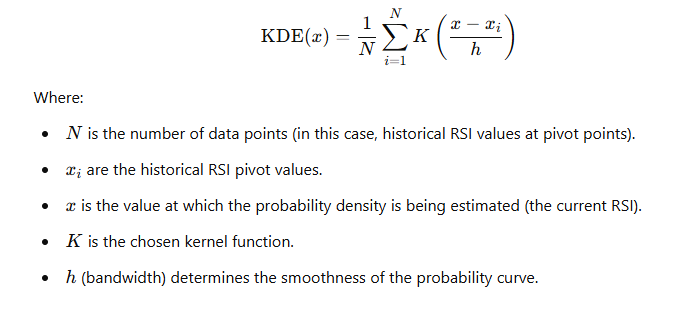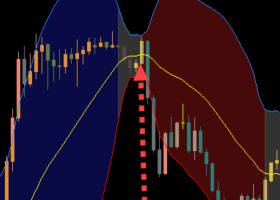The RSI (Kernel Optimized) indicator integrates Kernel Density Estimation (KDE) with the Relative Strength Index (RSI), creating a probability-based framework to determine how closely the current RSI level aligns with historically significant pivot points. By employing KDE, discrete historical pivot values are transformed into a smooth probability distribution, enabling more refined trend analysis than traditional RSI alone.
Core Concept: Kernel Density Estimation (KDE)KDE is a non-parametric method used to estimate the probability density function of a dataset. Instead of relying on discrete bins as in histograms, KDE applies a continuous kernel function over each data point to produce a smooth curve that represents probability density at every level of the variable being studied.
General KDE Formula:

Step-by-Step Logic
-
Collecting RSI Pivot Data: The process begins by identifying historical highs and lows in RSI data. These turning points are recorded as separate sets of RSI values: one set for pivot highs and another for pivot lows.
-
Selecting a Kernel Function: Several kernel options may be available, such as Gaussian, Uniform, and Sigmoid. Each kernel defines how influence diminishes as the distance from a data point increases.

-
Adjusting the Bandwidth (h): The bandwidth controls how wide and smooth the probability curve is:
- A smaller bandwidth highlights finer details and is more sensitive to individual data points.
- A larger bandwidth creates a smoother, more generalized probability distribution.
-
Constructing the Probability Distribution: After choosing the kernel and bandwidth, KDE is applied to the sets of pivot RSI values. The result is a continuous probability distribution, indicating how likely the current RSI is to be near historically significant pivot levels.
-
Evaluating Probabilities: Two primary methods can be used:
- Nearest Mode: Focuses on the probability density at the point closest to the current RSI value.
- Sum Mode: Integrates probabilities over a range, providing a cumulative sense of how strongly the current RSI matches historical pivot patterns.
A user-defined threshold determines when the probability is considered high enough to suggest that the current RSI closely resembles previous pivot conditions.
-
Generating Market Signals: By comparing the current RSI’s probability distribution to historical pivot distributions:
- A high probability of similarity to historical low pivots may signal a bullish opportunity.
- A high probability of similarity to historical high pivots may indicate a bearish scenario.
The threshold can be adjusted:
- A higher threshold results in fewer but more reliable signals.
- A lower threshold produces more signals but may include more noise.
-
Smooth Data Representation: KDE transforms discrete pivot data into a continuous, easily interpretable probability curve.
-
Probability-Based Analysis: Quantifying the likelihood of current conditions matching historical pivot points adds depth and robustness to RSI-based analysis.
-
Flexibility and Adaptability: Users can select the kernel function, adjust bandwidth, and choose probability evaluation modes to tailor the indicator to various market conditions.
-
Informed Decision-Making: Probability-driven insights help traders distinguish between random market fluctuations and genuine pivot-like behavior, improving confidence in entry and exit decisions.
By integrating KDE with RSI, the kernel-optimized logic provides a probability-based assessment of where the current RSI stands relative to historical pivot distributions. Through kernel selection, bandwidth tuning, and threshold adjustments, traders gain a more nuanced, statistically informed tool for identifying potential turning points in the market.
Download the RSI (Kernel Optimized) Indicator with Scanner using the Kernel Optimized Logic above with integrated Scanner of currency pairs, time frames here:
- for MT4: RSI Kernel Optimized with Scanner for MT4
- for MT5: RSI Kernel Optimized with Scanner for MT5



